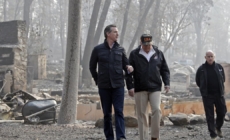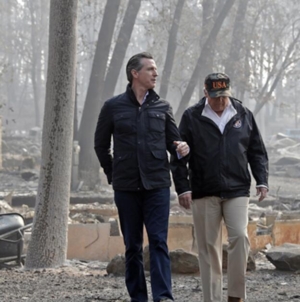-
Alex Bregman Favored To Land With AL Contender On $150 Million-Plus Deal - 7 mins ago
-
California man accused of beating his 62-year-old mother to death - 15 mins ago
-
Stakes are high for Newsom and California when Trump visits L.A. wildfires - 23 mins ago
-
Bills vs. Chiefs rivalry: Recapping every Josh Allen-Patrick Mahomes matchup - 29 mins ago
-
Woman Takes Son Out Of School Early To ‘Make Memories’ With Dying Dog - 46 mins ago
-
Big banks hiked interest rates on borrowers but not for savers, senators say - 51 mins ago
-
Pamela Ianetti was found dead with 47 stab wounds. Did she do it to herself? - 58 mins ago
-
Hiltzik: John Eastman’s fealty to Trump could cost him - about 1 hour ago
-
Taken captive as a baby, Israelis brace to learn the fate of Hamas’ youngest hostage - about 1 hour ago
-
2024-25 NBA odds: Phoenix Suns best bet to make playoffs - about 1 hour ago
Trump wants to alter California water policy. Experts say that would hurt state
In one of the first acts of his second term, President Trump is seeking to put his stamp on California water policy by directing the federal government to put “people over fish” and send more water from Northern California to the Central Valley’s farms and Southern California cities.
Trump issued a memorandum Monday ordering federal agencies to restart work to “route more water” from the Sacramento-San Joaquin River Delta to other parts of the state “for use by the people there who desperately need a reliable water supply.”
Trump directed his Interior and Commerce secretaries to report back on their efforts to implement the new policy by April 20. His order left unclear precisely how his administration will seek to carry out that objective.
President Trump speaks in the Roosevelt Room of the White House on Tuesday.
(Julia Demaree Nikhinson / Associated Press)
Karla Nemeth, director of the California Department of Water Resources, said the approach outlined by the president could do substantial harm by putting water supplies at risk as well as protections for vulnerable fish species.
Nemeth said Trump’s order, on its own, does not change anything and that the current rules for operating California’s water delivery systems in the Central Valley — which were supported by the state and adopted by the Biden administration in December — remain in effect.
Presumably, the president is directing the agencies to again start the lengthy process of revising the framework that governs how the two main water delivery systems, the State Water Project and the federal Central Valley Project, are operated.
“The process just completed in December 2024 took over three years, using the best available science to ensure the projects are operating in concert to balance the needs of tens of millions of Californians, businesses and agriculture while protecting the environment,” Nemeth said. “To abandon these new frameworks would harm California water users and the protection of native fish species.”
Trump similarly tried to alter California water regulations and policies during his first term. But when his administration adopted water rules that weakened environmental protections in the Delta, the state and conservation groups successfully challenged the changes in court.
That cleared the way for the Biden administration, working together with Gov. Gavin Newsom’s administration, to develop the current plan and the supporting biological opinions, which determine how much water can be pumped and how river flows are managed in the Sacramento-San Joaquin River Delta.
The rules govern the operations of dams, aqueducts and pumping plants in the Central Valley Project and the State Water Project, two of the world’s largest water systems, which deliver supplies to millions of acres of farmland and about 30 million people.
Pumping to supply farms and cities has contributed to the ecological degradation of the Delta, where the fish species that are listed as threatened or endangered include steelhead trout, two types of Chinook salmon, longfin smelt, Delta smelt and green sturgeon.
Trump said in his memorandum that his administration’s plan in his first term would have delivered “enormous amounts of water” but that because the state lawsuit led to a “catastrophic halt,” the additional water “flows wastefully into the Pacific Ocean.”
Trump has repeatedly claimed that the ongoing wildfires in Southern California underscore why the state should be delivering more water south from the Delta.
In an interview with Fox News this week, Trump threatened to tie federal aid for wildfire recovery to whether California accepts changes in water policy. “I don’t think we should give California anything until they let water flow down,” he said.
In a press briefing Tuesday, Trump said his administration will “take care of Los Angeles,” and he criticized the state for what he described as a lack of water flow.
“Los Angeles has massive amounts of water available to it. All they have to do is turn on the valve,” Trump said during a press briefing Tuesday. “They created an inferno.”
But water managers and experts have said Southern California’s cities are not currently short of water, pointing out that the region’s reservoirs are at record high levels following plentiful deliveries of supplies in 2023 and 2024.
Newsom has said a change in water management in Northern California would not have affected the fire response. The governor’s office said on social media that California “pumps as much water now as it could under prior Trump-era policies,” and that “there is no shortage of water in Southern California.”
Even with ample supplies in reservoirs, local water systems were pushed to their limits in places as the fires rapidly spread, driven by strong winds.
When the L.A. water system lost pressure in parts of Pacific Palisades, some fire hydrants ran dry in high-elevation areas, hindering the firefighting effort. Newsom last week ordered an investigation into the loss of water pressure to hydrants, and the lack of water available from a reservoir in Pacific Palisades that was out of commission for repairs.
“While water supplies from local fire hydrants are not designed to extinguish wildfires over large areas, losing supplies from fire hydrants likely impaired the effort to protect some homes and evacuation corridors,” Newsom said. “We need answers to how that happened.”
State officials have stressed that what Trump is proposing would do nothing to improve current water supplies in the Los Angeles Basin.
But Nemeth said if the Trump administration rejects the current water delivery rules and reverts to the earlier 2019 framework, that “has the potential to harm Central Valley farms and Southern California communities that depend upon water delivered from the Delta.”
The current rules and biological opinions provide additional flexibility that allows operators of the pumping facilities to the Delta to “respond more nimbly to real-time conditions,” Nemeth said. “Farms and cities have the potential to gain additional water supply, while endangered species are protected.”
Trump has indicated he intends to try to weaken environmental protection measures, and has questioned why the state should keep certain flows in rivers to help species such as the Delta smelt, “a little tiny fish.”

Federally endangered Delta smelt that were hatched at the UC Davis Fish Conservation & Culture Lab swim around a holding tank after being transferred from the lab to the Aquarium of the Pacific in Long Beach in 2019.
(Allen Schaben / Los Angeles Times)
“It’s a fish that’s doing poorly anyway,” Trump said this week.
Peter Gleick, a leading water and climate scientist, said Trump’s order on California water policy “is what you get when you mix bluster, ignorance, and disinformation.”
“There are no ‘enormous amounts of water’ that can be redirected legally, economically, or environmentally to different users in California, but perhaps this executive order will make some of Trump’s supporters feel like he’s doing something,” said Gleick, co-founder and senior fellow of the Pacific Institute, a water think tank in Oakland.
“He doesn’t really have a clue how California water systems work,” Gleick said. “If he cared about California water, which he doesn’t really, he would pay attention to climate change.”
Recent scientific research has shown that global warming, driven by fossil fuel burning and rising levels of greenhouse gases, has become a dominant driver of worsening droughts in the western U.S.
Examining the mix of factors behind the devastating wildfires, UCLA scientists said in an analysis last week that higher temperatures linked to climate change have contributed to the extreme dryness of vegetation in Southern California, one of the ingredients that is making the fires so intense.
“He doesn’t really have a clue how California water systems work. If he cared about California water, which he doesn’t really, he would pay attention to climate change.”
— Peter Gleick, co-founder and senior fellow of the Pacific Institute
Gleick said more than what the president says in “badly written executive orders,” people should watch what his appointees do — and how those actions affect efforts to improve water management.
“It remains to be seen just how disruptive Trump’s environmental appointments will be,” Gleick said. “The biggest risk is that it’s just going to delay or derail efforts underway to solve these problems.”
Trump’s call for delivering more supplies to farming areas and cities adds a layer of complication to arguments over water management in the Delta that have long pitted agricultural water districts against environmental groups, fishing advocates and Native tribes.
In recent years, fish populations have suffered major declines in the Delta and San Francisco Bay.
The numbers of spring-run Chinook salmon have plummeted. And with fall-run salmon populations struggling, officials shut down the commercial and recreational fishing seasons the last two years.
The longfin smelt, a species that once was abundant, was listed as endangered last year under the federal Endangered Species Act.
Environmental and fishing groups strongly criticized Trump’s water order.
Scott Artis, executive director of the Golden State Salmon Assn., said the previous rewriting of the rules during Trump’s first administration amounted to a “salmon extinction plan” because it deprived fish of critical flows they need to survive.
The closure of the salmon fishing season the last two years has already led to the loss of tens of thousands of fishing jobs, Artis said, and another weakening of protections “could further devastate fishing businesses, families, and communities.”
The group Save California Salmon said Trump’s directive continues a pattern of prioritizing the agriculture industry above the needs of other water users and the health of waterways and fish. The group also objected to the title of Trump’s memorandum, “Putting People over Fish: Stopping Radical Environmentalism to Provide Water to Southern California.”
“Protecting water quality, Delta smelt, salmon, and other species is not ‘radical environmentalism,’ ” said Josa Talley, a spokesperson for Save California Salmon.
“It is a matter of protecting water supplies and economies. Rivers must have enough water to sustain businesses, prevent toxic algae blooms, and ensure clean water for downstream communities,” Talley said. “Salmon survival is tied to our health and the health of our rivers.”
Times staff writer Colleen Shalby contributed to this report.
Source link





























